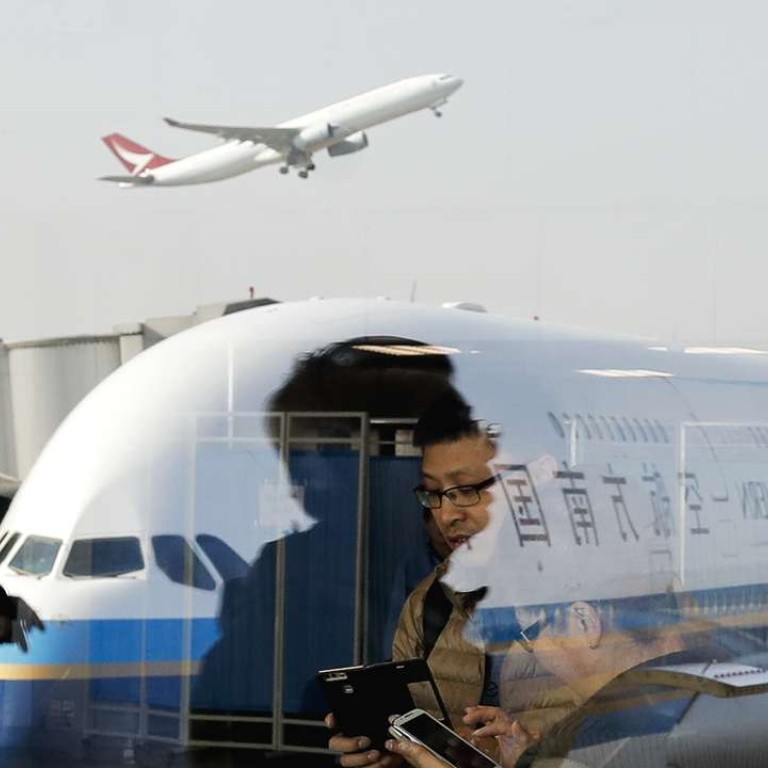
How booming outbound tourism is making China’s airports an attractive investment
The mainland’s major airports look set to be granted additional flight capacity as demand for air travel rises
Rising demand for air travel in China as outbound tourism booms is making airports an attractive investment, according to analysts.
Mainland tourists could make 200 million outbound trips by 2020, according to CLSA, while JP Morgan sees growth of 10 to 12 per cent in the coming two years. Outbound trips increased 4.3 percent to 122 million in 2016, data from the China National Tourism Administration show.
“We expect airports to be a better play on the growing tourism theme given that their earnings model is volume-driven with operating leverage gains, which should drive margin expansion,” said Karen Li, an analyst from JP Morgan in a report.
Driven by China’s rising tourist numbers, revenue passenger kilometres (RPK) - a measure of traffic for an airline flight - is expected to grow 16 per cent year on year in 2017, according to a forecast by BNP Paribas.
The bank sees airport capacity, or the number of slots available for flights, as the critical factor that could limit passenger growth, but industry insiders say the country’s major airports are likely to upgrade their capacity in the coming year.
“With continued strong demand for air travel [in China], we expect airport capacity to quickly become the bottleneck such that any increase in capacity, particularly slot capacity, becomes the main determinant of traffic growth,” said James Teo, an analyst from BNP Paribas.

“We believe these assumptions are reasonable because the slot increases are already approved in principle by the Civil Aviation Administration of China (CAAC) and it is merely a matter of timing as to when the increases will be granted,” said Teo.
Zhang Xiaoyun, an analyst from Industrial Securities, echoed this view and said the slot capacity at Shenzhen airport is very likely to reach 50 per hour in the first quarter of 2017.
Slot increases for Shanghai Pudong International Airport are less certain, however, as it has no ‘in-principle’ approval. It has not had any slot increases since 2014, even after its fourth runway was completed in 2015.
Teo said Shanghai may see its slot capacity increase in late 2017, assuming it has resolved issues of poor flight departure punctuality by then.
Beijing Capital International Airport is unlikely to receive any capacity increase in 2017, Teo added, as it is already very operating very close to its limit, at 96 per cent average slot utilisation during peak hours. It too was recently penalised by the CAAC for poor punctuality.
Shenzhen, Shanghai andGuangzhou Baiyun International Airport are expected to show robust traffic growth in 2017, with passenger throughput likely to rise between 7.3 to 10 per cent, according to BNP Paribas. Beijing airport, on the other hand, may see growth of just 2.6 per cent due to capacity constraints.
Growth in international traffic is particularly good news for the airports’ margin as data shows international passengers spend up to eight times more than domestic customers at airports.
JP Morgan said the growth prospects for international traffic remain stronger than for domestic air travel in China.
Higher profits could also come from the healthier margins in the ‘non-aeronautical’ segment in China’s major airports.
Beijing airport, for example, is putting its duty-free concession out for tender, a move which may bring in higher rental rates due to the competitive bidding expected between incumbent Sunrise Duty Free and China Duty Free Group.
Shanghai airport expanded its retail space and duty-free shop in the arrivals hall, which is likely to strengthen its profitability. Guangzhou and Shenzhen are scheduled to open duty-free shops for arriving passengers for the first time by October 2017.
Airport tariffs are under CAAC review, with non-aeronautical fees likely to be priced according to the market and aeronautical tariffs likely to increase in 2017.
“Both developments may lead to margin expansion for Chinese airports, and serve as positive share price catalysts when announced by the CAAC,” said Teo.
Airport operations tend to be less exposed to rising oil prices and yuan depreciation than airlines are, but Teo warned the slowdown in China’s economic growth could be a potential risk.
Lu Da, an analyst from SWS Research, said the airport industry can serve as a good defensive investment amid weak markets, as operators generally have strong cash flow and high dividends but low valuation.
BNP Paribas maintains Shenzhen airport as its top pick because of its imminent slot capacity increase, its rising international traffic mix and the addition of its arrivals duty-free this year.
Industrial Securities also maintains a “Buy” rating for Shenzhen Airport.
BNP Paribas upgraded Shanghai and Beijing’s airports to “Buy” from “Hold” but maintain Guangzhou airport at “Reduce”.

